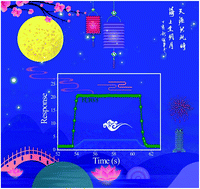Nano-porous hollow Li0.5La0.5TiO3 spheres and electronic structure modulation for ultra-fast H2S detection†
Abstract
Ultra-fast detection of hazardous gases with high selectivity is important for environmental safety monitoring. In this study, we report a Li0.5La0.5TiO3 (LLTO) sensor with an ultrafast response to H2S. We used a simple solvothermal method to controllably synthesize hollow LLTO nano-spheres. The LLTO nano-spheres had a porous surface structure, which provides sufficient channels for diffusion of H2S gas. Response/recovery speeds of 0.7 s/0.8 s were achieved at an optimum working temperature of 340 °C. To further improve the response, the band structure was modulated by Fe doping (FLTO). When doped with Fe3+, more oxygen vacancies were generated which enhanced the chemical absorption of O2 and generation of active oxygen species (O− and O2−). Furthermore, the band gap was also narrowed and the conduction band was elevated by 0.44 eV, which promoted charge transfer from the conduction band of FLTO to chemisorbed gas molecules. After doping, the response was 5.5 times as great as that of the pristine LLTO sensor for 30 ppm H2S and the optimum temperature decreased to 300 °C. In addition, the detection limit was as low as 100 ppb. The doped LLTO sensor also had good repeatability and long-term stability.

- This article is part of the themed collection: Journal of Materials Chemistry A HOT Papers


 Please wait while we load your content...
Please wait while we load your content...